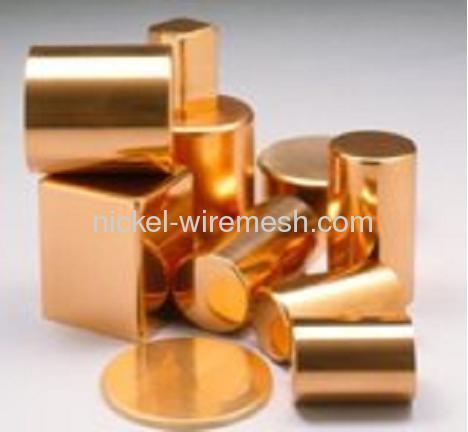You are here: home > Learning Gallery > Nickel Copper Alloys
Product (745)
- Pure Nickel Products (38)
- Incoloy Products (74)
- Inconel Products (72)
-
FeCrAl Product
(99)

-
Nichrome Products
(68)

- Monel Products (36)
- Hastelloy Products (49)
- Nickel Iron Alloy Product (59)
-
Nickel Copper alloys
(47)

- Nonferrous Metal Product (27)
-
Resistance Wire
(90)

- Stainless Steel Product (48)
- Mesh Demister (20)
- Others (18)
Product Forms (14)
Quality Certificate (11)
Learning Gallery (30)
Incoloy News (9)
Inconel News (22)
Molybdenum News (7)
Nikrothal News (4)
Nichrome News (13)
Titanium News (2)
Nickel News (8)
Alloys House (30)
Tools (27)
Nickel alloy News (30)
Latest Buzz (30)
nickel chrome copper iron alloys news (28)
Credit Report
Products Index
Company Info
Heanjia Super-metals Co., Ltd. [China (Mainland)]
Business Type:Manufacturer, Trading Company
City: Beijing
Province/State: Beijing
Country/Region: China (Mainland)
Learning Gallery
Nickel Copper Alloys

COPPER-NICKEL ALLOYS
1: Background
Copper-nickel alloys (often referred to as cupro-nickels) offer moderate to high strength and excellent resistance to various waters, including seawater and form a protective surface film in such conditions. In addition they provide good anti-fouling properties and weldability.
The precipitation hardenable copper nickels (DEF STAN 02-835 and ULTIBRON™-NB) possess high strength and are used as an alternative to the 90/10 and 70/30 alloys and other copper alloys such as nickel aluminium bronze in marine applications. Other useful attributes include low magnetic permeability, imperviousness to hydrogen embrittlement, no loss of impact strength down to minus 196°C and good jet impingement resistance.
There exists a range of different copper nickel alloys that possess different properties and hence are suited to a range of different applications. Some of the better known copper nickel alloys include:
l Copper with 10% nickel
l copper with 30% nickel
l Copper with 25% nickel with 0.05-0.4% manganese
l Copper with 45% nickel (also known as constantan)
All copper nickel alloys consist of only one phase as the copper nickel binary system exhibits complete solid solubility.
2: Copper-Nickel Alloy Key Properties
Properties vary with composition; however, some properties are outlined below.
Copper 90/10 and Copper 70/30
l Outstanding resistance to corrosion, particularly sea water
l 70/30 is stronger and has superior resistance to impingement corrosion
l Good resistance to biofouling, with the 90/10 alloy being slightly superior compared to the 70/30 alloy
Copper rich alloys are:
l Ductile
l Can be hardened only by cold working
l Good corrosion resistance
l Good strength
l Low temperature co-efficient of electrical resistance
The nickel content in these alloys also enables them to retain their strength at elevated temperatures compared to copper alloys without nickel.
3: Copper-Nickel Alloy Applications
3: Copper-Nickel Alloy Applications
Sea Water Condensor Systems and Desalination Plants
Due to the good resistance to sea water corrosion, the 90/10 and 70/30 alloys are employed for sea water condenser systems and in desalination plants, as well as pipe work in chemical plants.
Automotive Applications
Due to the fact that the 90/10 alloy requires no surface protection and hence gives extra safety, this alloy is being increasingly employed for brake and hydraulic suspension systems and cooling systems in cars and commercial vehicles.
Marine Applications
The good resistance to biofouling and sea water corrosion resistance of the 90/10 and 70/30 alloys have lead to its use in applications such as cladding for ships' hulls, legs of oil rig platforms and sea water intake screens.
Coins
The copper with 25% nickel with 0.05-0.4% manganese is commonly used for the manufacture of coins, medals and other semi valuable applications.
Resistance Wire
Due to the very low temperature co-efficient of electrical resistivity, the copper with 45% nickel alloy is used for resistance wire in high precision resistors. This property allows the resistor to operate at almost exactly the same resistance regardless of temperature.
Thermocouples
The copper-45% nickel alloy is also used for thermocouples as it develops a high and uniform EMF when coupled with other metals such as copper and iron.
Other Applications
Cooling circuits, ammunition, sea water corrosion-resistant assemblies, and condenser tubes.
Pre Page:
What is Nickel?
Next Page:
Nickel-Chromium-alloys



